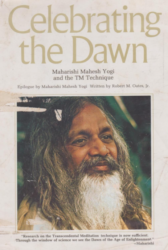Creativity, Transcendental Meditation and Brain Integration

Growing up, I was taught that creativity was a highly prized commodity. My father was a product engineer for International Harvester, designing plows and farm equipment, and earned 22 patents. When he retired from that, he and his brother designed a nifty cable-laying machine that laid wires in the ground while leaving behind only a tiny slit—and is still popular 40 years later. His most amazing creative achievement, though, was a passive-solar home that he designed in 1959 and built out of all-natural materials with his own hands. Our family dearly loved the magical and beautiful home he built for us.
My dad taught us that anyone can be creative. You didn’t have to be a famous scientist like Madame Curie or a famous dancer like Isadora Duncan to be highly creative in your everyday life, he said. He pointed out that the world is filled with people who create amazing things every day.
Yet even as a child it was clear to me that some people come by the creative gene more easily than others. So I was interested to read a new study on creativity by Fred Travis, Ph.D., and Yvonne Lagrosen, Ph.D., published this month in Creativity Research Journal. The researchers found that brain integration is a common feature among highly creative people.
“It’s a simple fact that some people stand out as creative, and we’re trying to tease out why,” Dr. Travis says. “We hypothesized that something must be different about the way their brains work, and that’s what we’re finding.”
Dr. Travis has developed a measure that he calls “brain integration.” He analyzes EEG patterns to assess brain wave coherence (connectedness) in the frontal brain. He also assessed alpha power, a measure of inner directedness of attention, and the brain’s preparation response, which measures how efficiently the brain responds to a stimulus.
In this study, Dr. Travis and Dr. Lagrosen studied 21 Swedish product engineers—who, like my dad, were designing new products as part of their jobs. The researchers found that those with the highest brain integration scored the highest in creativity as measured by standardized Torrance measures — as well as other characteristics of highly creative people such as speed of processing information, speed of executive decision-making and a factor called “Sense-of-Coherence,” which means a sense of being in control of one’s situation.
In previous studies in collaboration with Dr. Harald Harang, Dr. Travis had found greater brain integration in world-class athletes, top managers and professional musicians. In other words, he is finding that brain integration may be the underlying factor that leads to success in many different areas.
Dr. Travis says, “While there’s a common notion that 10,000 hours of practice is necessary for high achievement, some people put in long hours and do not excel. This new research and previous studies suggest that brain integration may be the inner factor that leads to outer success.”
So the next question is—can a person develop greater brain integration, and thus increase their creativity and ability to succeed?
As Dr. Travis points out, the regular practice of the Transcendental Meditation technique has been found to increase levels of brain integration and to increase creativity in many randomized controlled, peer-reviewed studies.
There are other ways that the TM technique heightens mental abilities. For instance, it helps relieve the mental fatigue that can stand in the way of creativity. For instance, when women are tired or stressed, they can’t be as clear, present or creative as they would like to be.
I found my own creativity soaring when I started to practice TM at age 19. Gone was the writer’s block, the struggle with realizing my inner vision on paper. And as I was able to express my true self in my writing, I felt happier and more self-confident in other areas of life as well.
It is my belief that creativity is an essential part of being a woman—after all, we have the ability to create the miracle of human life. So a practice that allows us to come in contact with our inner source of creativity, happiness, and power is something that can benefit every woman.
So if you want to give your creativity a boost, consider learning the Transcendental Meditation technique and seeing the effect of regular transcending on inner happiness and outer success.
I think that Madeleine L’Engle, the author of A Wrinkle in Time, says it so well: “But unless we are creators we are not fully alive. What do I mean by creators? Not only artists, whose acts of creation are the obvious ones of working with paint of clay or words. Creativity is a way of living life, no matter our vocation or how we earn our living. Creativity is not limited to the arts, or having some kind of important career.”
About the Author
Linda Egenes writes about green and healthy living and is the author of six books, including The Ramayana: A New Retelling of Valmiki’s Ancient Epic—Complete and Comprehensive, co-authored with Kumuda Reddy, M.D.
More Posts by Linda
- Tired and Burned Out? Transcendental Meditation Can Help: An Interview with Dr. Nancy Lonsdorf, MD
- Worried About the Future? Six Ways to Calm Your Anxiety
- What Do You Carry in Your Self-Care Tool Kit?
- Five Strategies for Family Caregivers
- From the Streets to College in Four Months: The Communiversity of South Africa Empowers Underserved Youth in Cape Town





